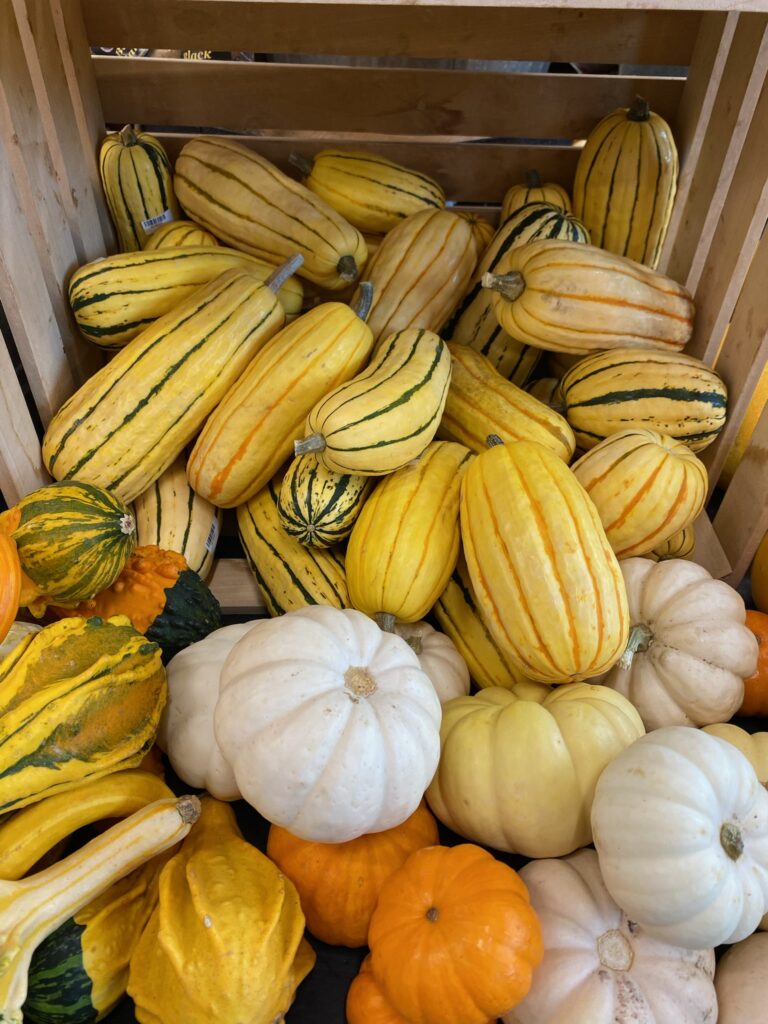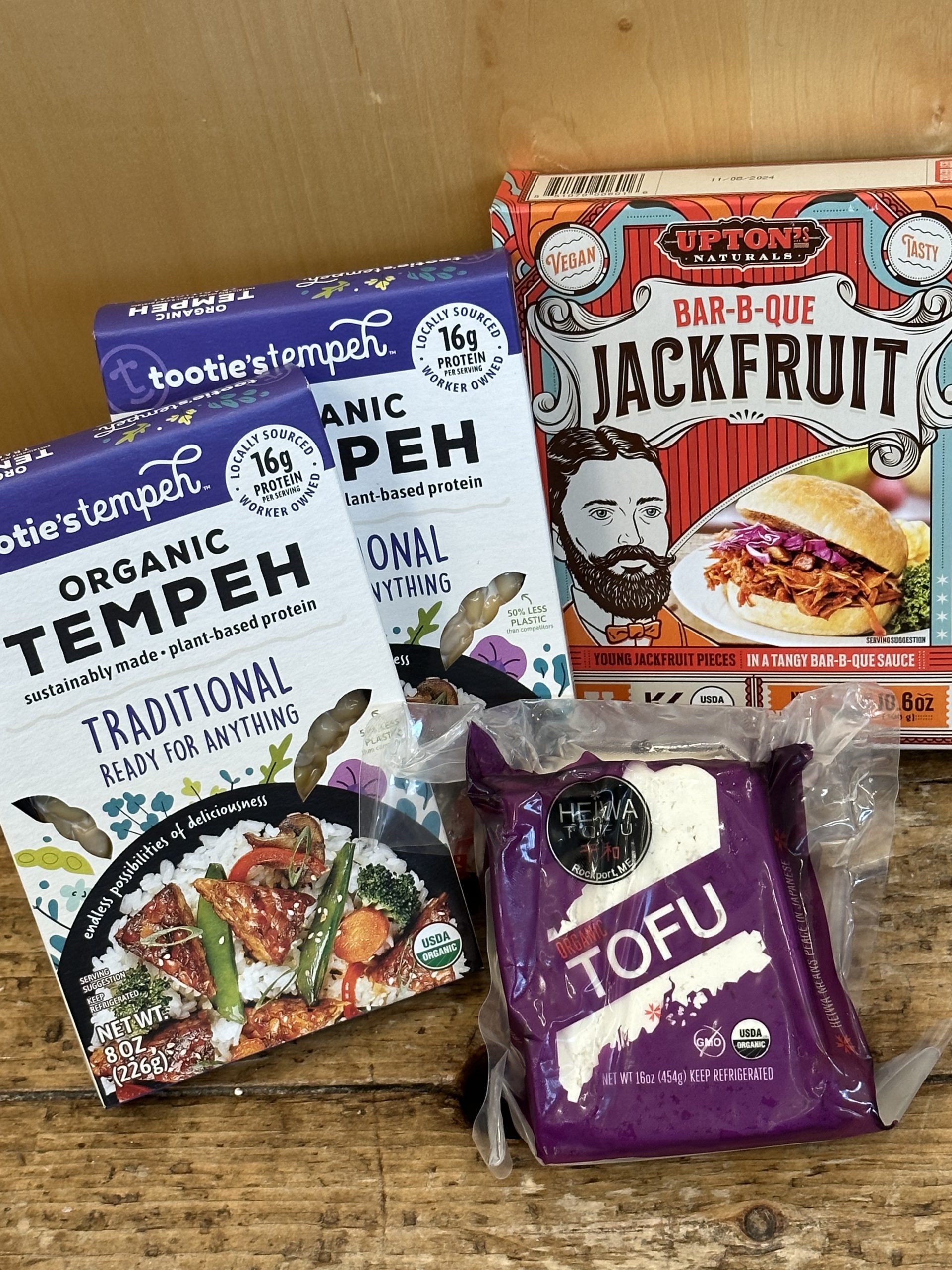Winter squash are the fruit of several species within the genus Cucurbita. As opposed to summer squash varieties, winter squash are harvested late in summer and Autumn and can weather the winter in storage. Some rounder varieties, especially orange ones, are called pumpkins. Winter squash originated in the Americas and are believed to be one of the first crops cultivated by Indigenous Americans. Some varieties, known as heirlooms, have been around for a long time; others are modern cultivars created by selective cross-planting and hybridization. It’s important to note these modern types are not created by genetic modification. Each squash variety has its own special qualities, and this guide will help you navigate some common and not-so-common varieties.

Acorn Squash
Acorn squashes have been grown in North America for centuries. They’re believed to be one of the first crops cultivated by Indigenous Americans. Squash, including acorn varieties, was part of the “Three Sisters” crop of squash, corn, and beans, which was a staple of many Indigenous cultures.
Acorn squash is great for roasting, baking, stuffing, broiling, sautéing, steaming, and grilling. It is especially good sliced in half, baked until tender, then stuffed with meat and veggies, and baked again.
Type: heirloom
AKA: pepper squash, Des Moines squash
Size: 1-2 lbs
Flavor: mildly sweet and nutty
Texture: tender and somewhat dry texture
Storage: one month (uncut, in a cool and dry place)
Goes well with: balsamic vinegar, wild mushrooms, brown sugar, maple syrup, sage, thyme, rosemary, robust cheeses, curry, pecans, butter, dried cranberries, cilantro, ground beef, blackened chicken, sausage, and apple
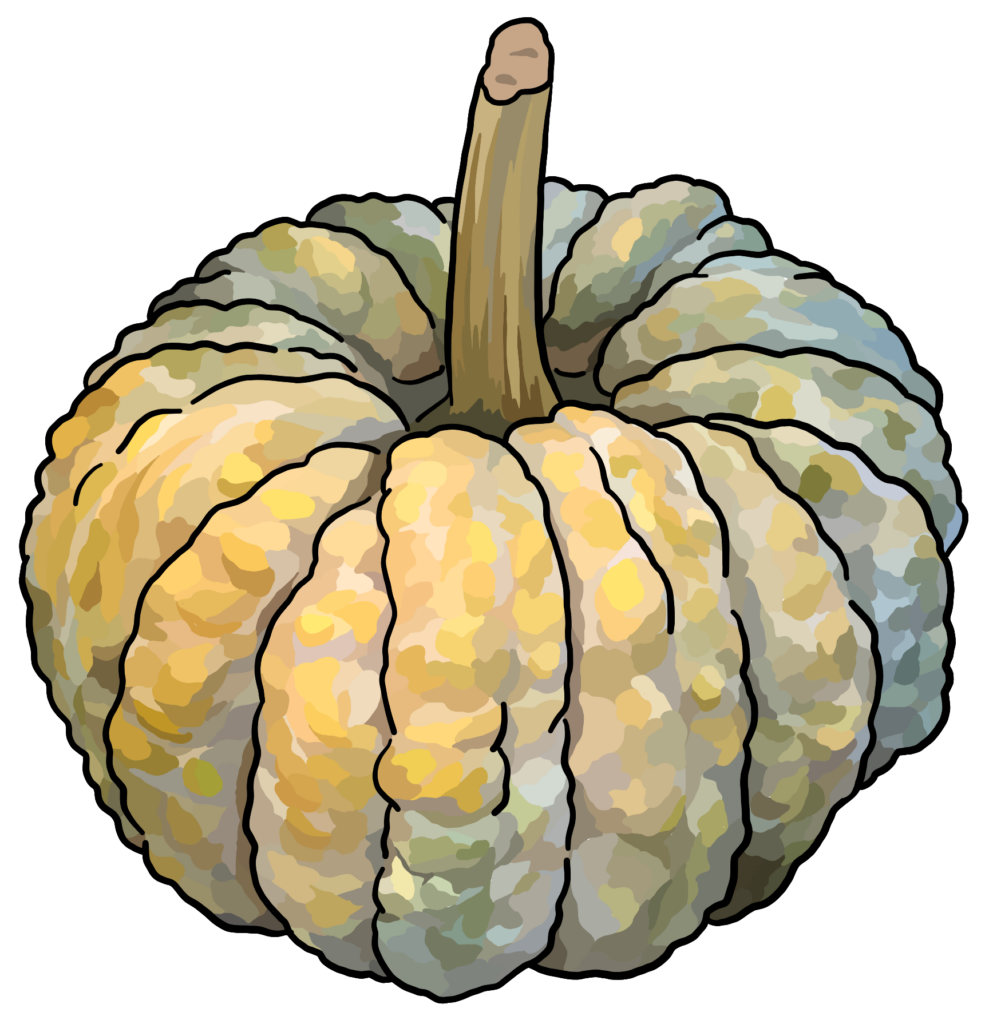
Black Futsu Squash
Black futsu come from Japan. It is believed they were originally an open-pollinated cultivar from squash brought from the Americas by Portuguese traders. They’re usually 3-5 pounds and are ribbed, bumpy, and sometimes warty.
They’re great sliced thinly and added raw to salads, slaws, or layered on cheese and fruit plates. They can be battered and fried into tempura, lightly stir-fried with winter vegetables, tossed into soups and stews, sliced into wedges and roasted, or stuffed with grains, meats, or cheeses.
Type: heirloom
Size: 3-5 lb
Flavor: similar to roasted chestnuts
Texture: smooth and creamy
Storage: six months (uncut, in a cool and dry place)
Goes well with: rosemary, sage, parsley, fennel seeds, turmeric, paprika, cayenne, cinnamon, honey, ginger, chicory, kale, radicchio, raisins, dried cranberries, coconut milk, tahini, rice, pecorino cheese, sesame seeds
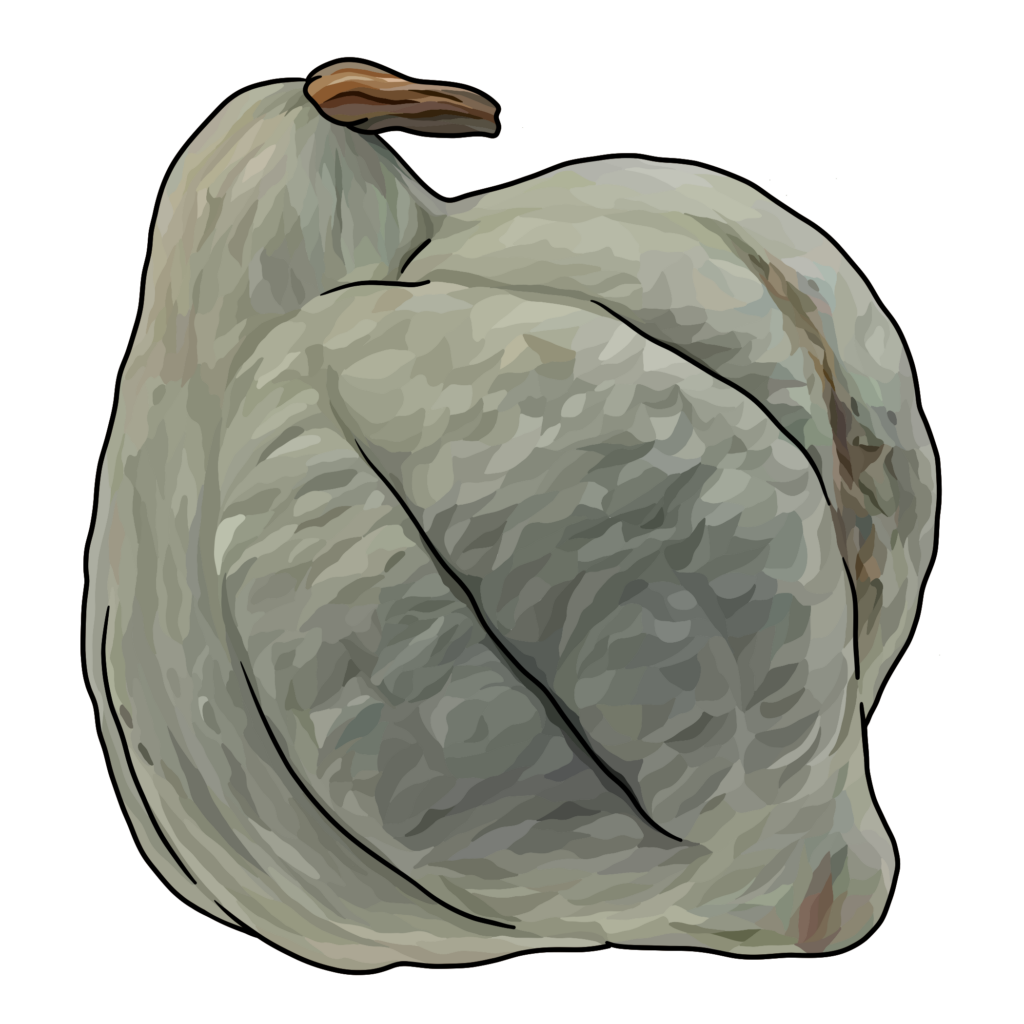
Blue Hubbard Squash
Hubbard squashes are originally from South America, but in the mid-1800s, a sea captain brought them to North America. They became very popular, especially with the higher classes, who thought of them as more refined than the common pumpkin. Blue Hubbard is by far the most well-known variety.
When cooked, Hubbard can be added to pies, casseroles, risotto, and pasta preparations. It can also be pureed and added to soups, stews, sauces, curries, and desserts.
Type: heirloom
Size: 5-40 lb
Flavor: rich, semi-sweet, similar to cooked pumpkin
Texture: tender and starchy
Storage: six months (uncut, in a cool and dry place)
Goes well with: sage, rosemary, thyme, oregano, coriander, cinnamon, cloves, nutmeg, swiss chard, spinach, kale, peas, beans, hazelnuts, lobster, ham, potatoes, tomatoes, apples, and Gruyère cheese
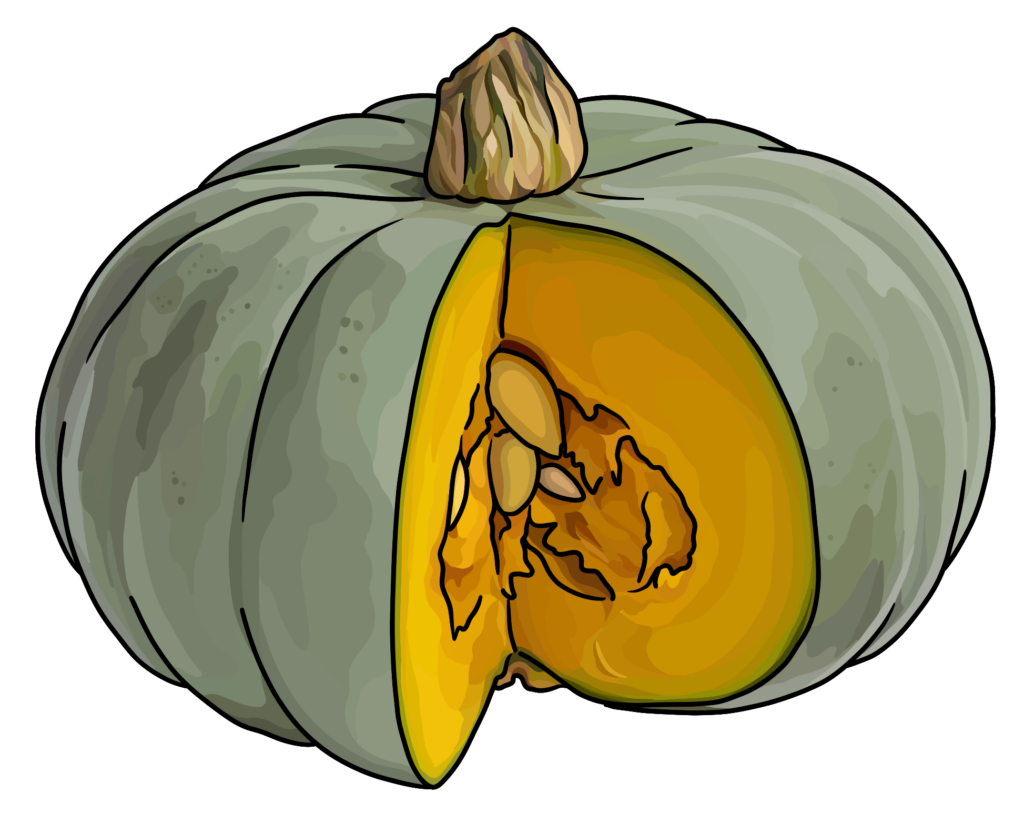
Blue Pumpkin
There are many varieties of blue pumpkins grown for ornamental and culinary uses. They’re native to the Americas and are one of the rarest color variants. Blue pumpkins are particularly loved in Australia, where they were introduced in the 1780s.
Blue pumpkins vary by specific cultivar, but they are often cut into chunks and roasted or steamed as a side dish. They can also be added to baked preparations like cakes, scones, and pancakes.
Type: heirloom
Size: varies by cultivar but generally 4-25 lbs
Flavor: rich, mild, sweet
Texture: smooth, dry
Storage: three to six months (uncut, in a cool and dry place)
Goes well with: onions, garlic, ginger, shallots, parmesan, feta, mozzarella, thyme, rosemary, parsley, cinnamon, nutmeg, allspice, curry powder, dried fruits
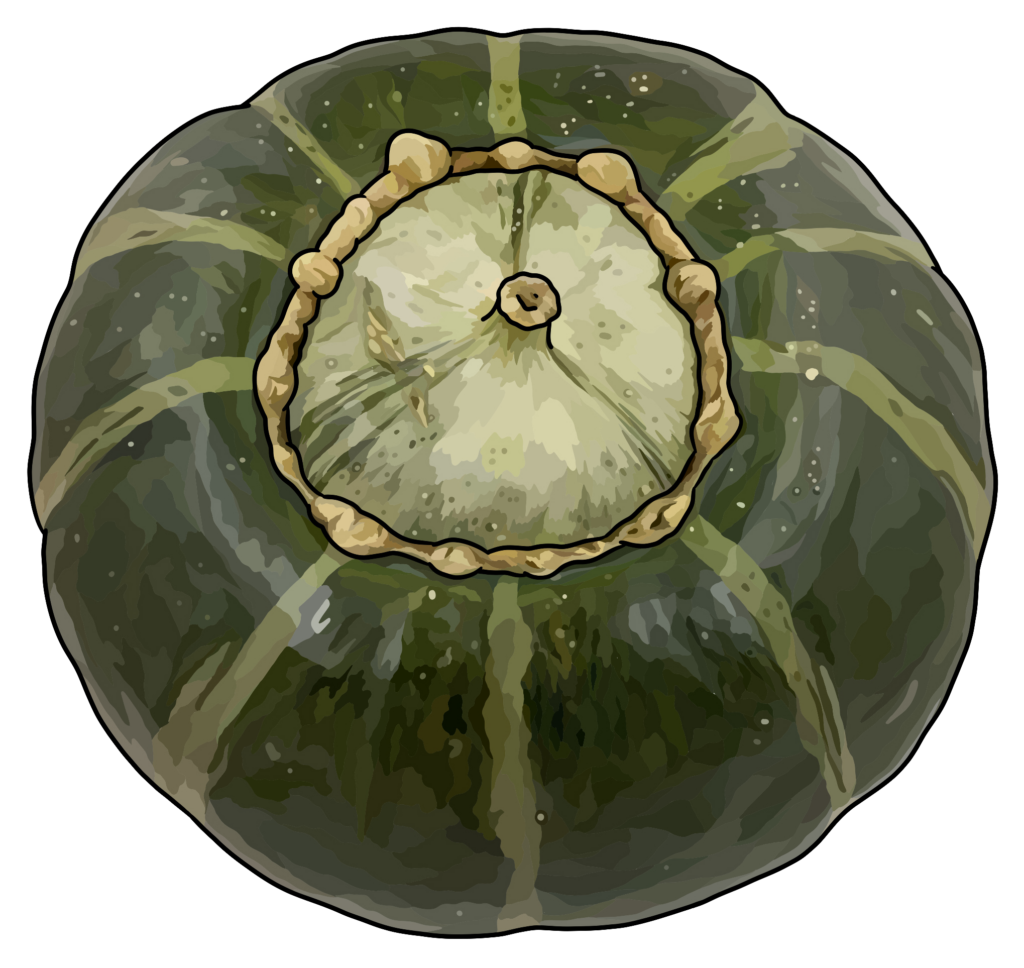
Buttercup Squash
This popular squash variety was originally a chance seeding discovered at the North Dakota State University Agricultural Experiment Station in 1925. It is believed to be a cross between two other varieties. From there, it underwent years of selection and self-pollination until it was released in 1931. It was marketed as a replacement for sweet potatoes, which were challenging to grow in North Dakota.
Today, it’s one of the most loved squash varieties for its creamy, satiny texture and sweet flavor. Buttercup is best for baking, steaming, or roasting. It can also be pureed and used in soups, ravioli, risotto, curries, and pies.
Type: heirloom
Size: 3-5 lb
Flavor: mild, sweet flavor similar to chestnuts and sweet potatoes
Texture: semi-dry, satiny, and smooth
Storage: three months (uncut, in a cool and dry place)
Goes well with: hard cheeses, nuts, brown sugar, ground beef, lentils, cinnamon, nutmeg, and fresh herbs such as sage, cilantro, chives, and parsley
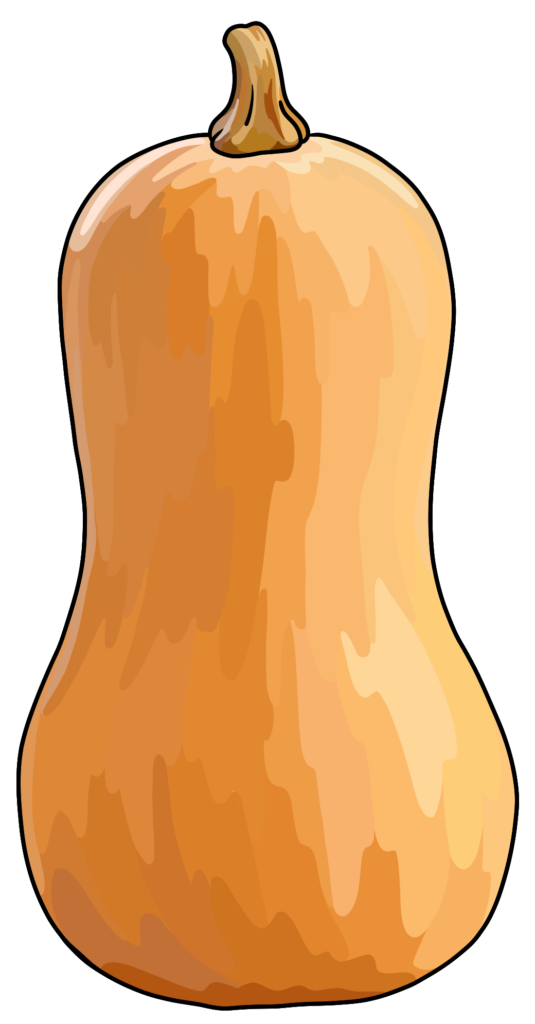
Butternut Squash
Butternut squash is a relatively recent cultivar and is a hybrid between the crooked neck or gooseneck squash and squatter varieties. It took many years of development during the 1930s and 40s to develop a variety that consistently grew straight-necked squash. Today, it’s one of the most popular and readily available squash varieties.
Butternut are suitable for roasting, toasting, steaming, sautéing, baking, braising, and grilling. It can be sliced into rounds, wedges, or cubes and added to curries, chili, soups, stews, risotto, a filling for tacos, enchiladas, empanadas, and ravioli. Butternut squash can be used in baked goods such as pies, bread, and muffins.
Type: hybrid
Size: 2-5 lb
Flavor: sweet and nutty nuances
Texture: tender and moist
Storage: one to two months (uncut, in a cool and dry place)
Goes well with: sage, thyme, bay leaf, apple, cinnamon, pear, shallots, pecans, butter, cream, feta cheese, ground beef, sausage, and bacon

Carnival Squash
The carnival squash is a fairly recent cultivar that first became available to gardeners in 1991. It is a hybrid of dumpling and acorn squash. In recent years, it’s gained popularity due to food and lifestyle bloggers utilizing its decorative appearance.
Carnival squash can be roasted whole, cut in half or into pieces, and blended to become soup or sauce and added to stews, risottos, curries, or pasta dishes. The squash can also be utilized as an edible vessel as its size often lends itself to healthy, individual serving portions.
Type: hybrid
Size: 1-2 lb
Flavor: slightly nutty, buttery, and sweet with nuances of maple syrup, similar to butternut squash
Texture: soft and tender
Storage: one month (uncut, in a cool and dry place)
Goes well with: pork, lamb, sausage, other roasted winter vegetables, maple syrup, toasted walnuts and pecans, sage, apples, pepitas, red chard, and aged cheeses such as pecorino
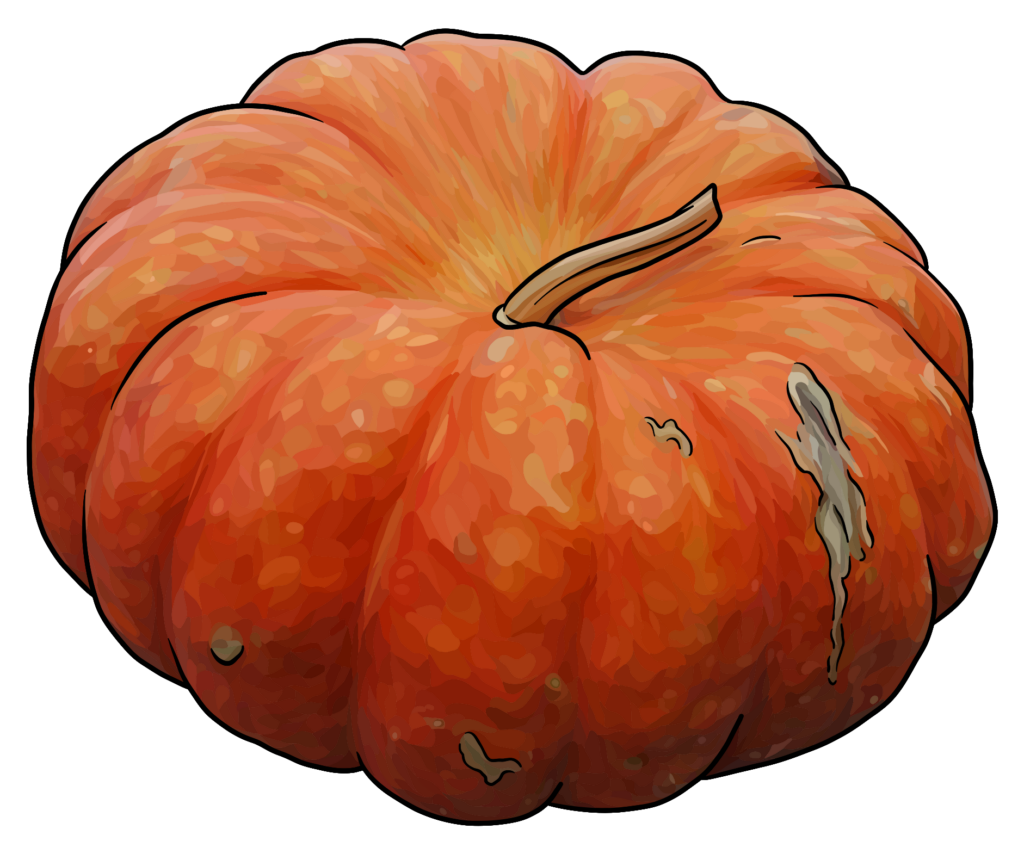
Cinderella Squash
These beautiful, deep orange pumpkins originated in France in the medieval town of Etampes. Their original name – Rouge Via d’Etampes – translates as “bright red from Etampes.” After Disney’s 1950 film Cinderella was released, these pumpkins gained a new name in the US. In fact, it’s said the artist for the movie used a Cinderella squash as a reference when designing the pumpkin carriage.
Though the Cinderella pumpkin is generally sold for ornamental purposes today, it is edible and tasty. They can be baked, roasted, or steamed and are best for sweet applications like pies, cakes, muffins, and even gelato.
AKA: Rouge Vif d’Etampes, cheese pumpkin
Type: heirloom
Size: 15-24 lb
Flavor: mild and slightly sweet
Texture: creamy and moist
Storage: three to five month (uncut, in a cool and dry place)
Goes well with: sausage, poultry, bacon, turkey, carrots, celery, parsnips, rutabagas, cabbage, green and red bell peppers, broccoli, zucchini, corn, mushrooms, garlic, onions, chives, cream cheese, cinnamon, honey, rice, quinoa, parsley, Italian seasoning, rosemary, thyme, cheddar, Emmental, and Gruyère.
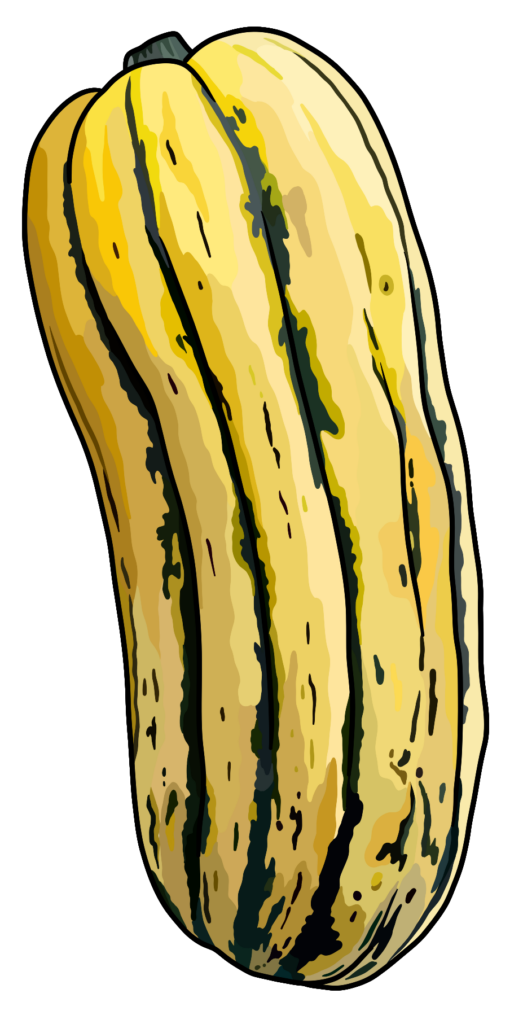
Delicata Squash
This oblong squash variety was developed in the late 1800s and became very popular. However, during The Great Depression, it lost favor due to its low yield, vulnerability to disease, and shorter shelf life. It wasn’t until the 1990s that it regained favor with American consumers. As the name suggests, delicata has a delicate, thin skin that is edible and pleasant.
Delicata holds its shape well through cooking, making it an excellent choice for stuffing with grains, meats, or cheese and baking and serving as a side dish. Delicata squash can also be sliced into rings or cubes and used in an endless array of recipes.
AKA: Bohemian squash, Peanut squash, and Sweet Potato squash
Type: heirloom
Size: 1-2 lb
Flavor: sweet with a flavor similar to a sweet potato
Texture: medium moisture, fine grained
Storage: 3 weeks (uncut, in a cool and dry place)
Goes well with: apple, pear, fennel, kale, spinach, arugula, garlic, shallot, parsley, sage, lemon, maple syrup, butter, toasted pecans, hazelnuts, and walnuts, quinoa, eggs, white beans, dried cranberries, cinnamon, nutmeg, brown sugar, Italian sausage, ground beef, roasted poultry, feta, blue, parmesan, and mozzarella cheeses
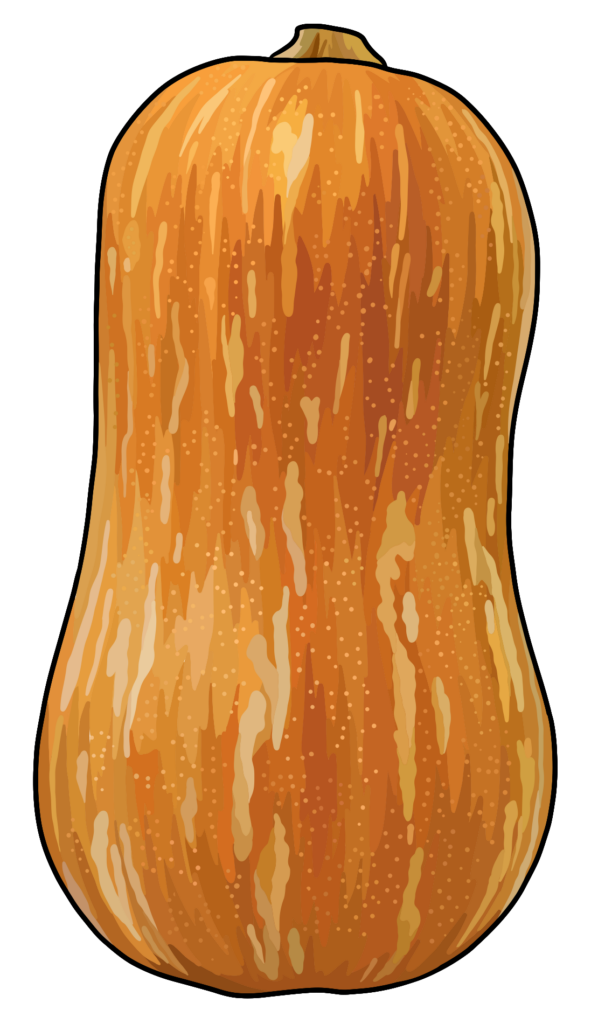
Honeynut Squash
Honeynut is a hybrid of butternut and buttercup squashes. It was initially hybridized in the 1980s at Cornell University’s Agricultural Experiment Station but didn’t become available to farmers until 2015, after many years of perfecting. The university worked with chefs and seed companies to develop this incredibly delicious variety.
The recommended preparation for this sweet squash is roasting, which allows the sugars in the flesh to caramelize, maximizing the squash’s flavor profile. Honeynut squash can be used in any recipe calling for butternut or other winter squash varieties and can be added to soups, stews, or braising liquids.
Type: hybrid
size: 1-1.5 lb
Flavor: sweet, nutty, caramel, and malt-like flavor
Texture: tender and creamy
Storage: one month (uncut, in a cool and dry place)
Goes well with: radicchio, kale, miso, green apples, pine nuts, farro, quinoa, garlic, onion, chives, thyme, sage, nutmeg, cinnamon, Parmigiano Reggiano, mushrooms, corn, black beans, maple syrup, and honey
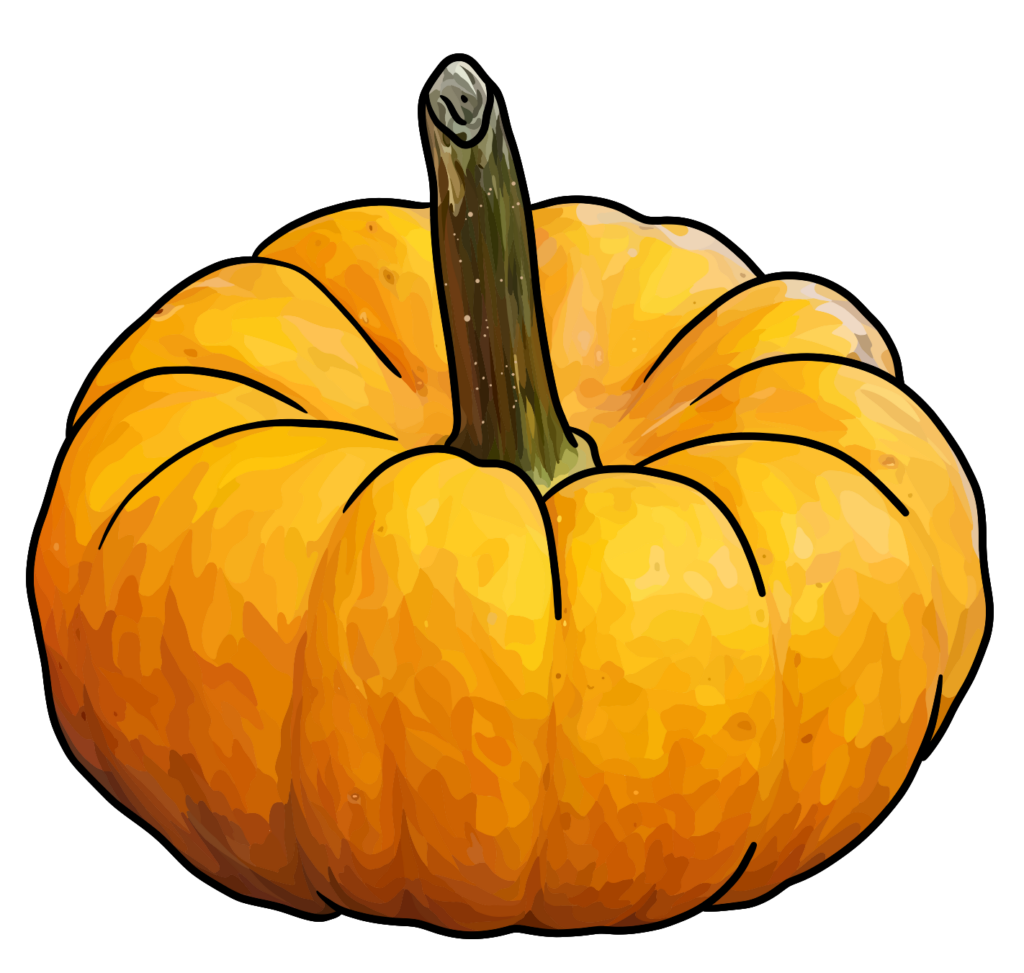
Jack Be Little Pumpkin
Mini pumpkins have been cultivated alongside larger varieties for centuries. They shifted from a food crop to a seasonal decoration after WWII, when sugar rationing ended and trick-or-treating became a cultural norm. People needed ways to decorate, and jack-o-lanterns and mini pumpkins became the go-to. Jack be littles are one of the most popular varieties.
Though they are more common for decor, Jack be littles are edible and fun to cook. Because of their small size, they make great vessels or edible ramekins. You can stuff them with meats and veggies or make custards, cheesecakes, or crème brulee inside them.
Size: 170-340 grams
Flavor: mild and slightly sweet
Texture: tender and smooth
Storage: six to twelve months (uncut, in a cool and dry place)
Goes well with: black beans, quinoa, couscous, Brussels sprouts, cauliflower, mushrooms, garlic, red and green onions, currants, pine nuts, cinnamon, sage, and thyme

Jack-o-Lantern Pumpkin
This variety of pumpkin was specifically cultivated for Jack-o-lanterns. Its long body and smooth surface are perfect for carving. Jack-o-lanterns originated hundreds of years ago in Ireland, where people made lanterns out of turnips, rutabagas, potatoes, beets, and other vegetables to scare away the ghost of Stingy Jack. Pumpkins are from the Americas, so it wasn’t until Irish immigrants reached North America that the more familiar Jack-o-lanterns appeared. Since pumpkins are larger and much easier to hollow out, the old turnip was discarded.
Though this cultivar is used for carving, it can be used the same way as pie pumpkins.
Size: 7-10 lb
Flavor: mildly sweet, earthy, and nutty
Texture: tender and buttery
Storage: two to three months (uncut, in a cool and dry place)
Goes well with: sage, rosemary, thyme, oregano, coriander, cinnamon, cloves, nutmeg, Swiss chard, spinach, kale, peas, beans, hazelnuts, lobster, ham, potatoes, tomatoes, apples, and Gruyère cheese
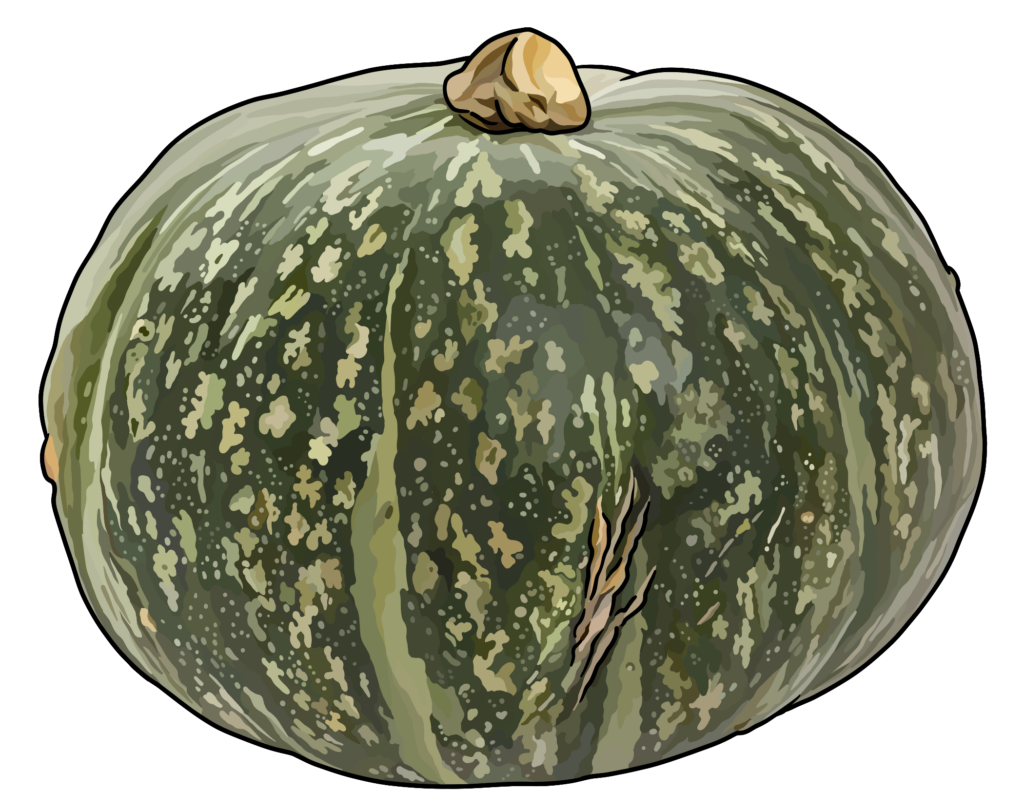
Kabocha Squash
Kabocha is a Japanese squash variety cultivated since the 1500s when Portuguese traders introduced it. In Japan, the word kabocha refers to squash and pumpkins in general, but in the US, it’s used just for this specific variety, known as kuri kabocha in Japan.
Kabocha can be added in cubes to gratins, risottos, soups, stews, curries, and pasta. It can also be roasted on its own, battered and fried tempura-style, or used in sushi. When cooked and puréed, it can be used to make bread, croquet, desserts, cakes, and sauces.
AKA: Japanese pumpkin, kuri kabocha, haku haku
Type: heirloom
Size: 1-8 lb
Flavor: buttery, sweet, and rich, nutty flavor reminiscent of sweet potato and pumpkin
Texture: finely grained, dry, tender
Storage: one to three (uncut, in a cool and dry place)
Goes well with: pears, apples, lemon, kale, spinach, eggplant, garlic, sage, parsley, shallots, cilantro, nutmeg, clove, curry spice, honey, brown sugar, coconut milk, butter, cream, Italian sausage, and parmesan cheese
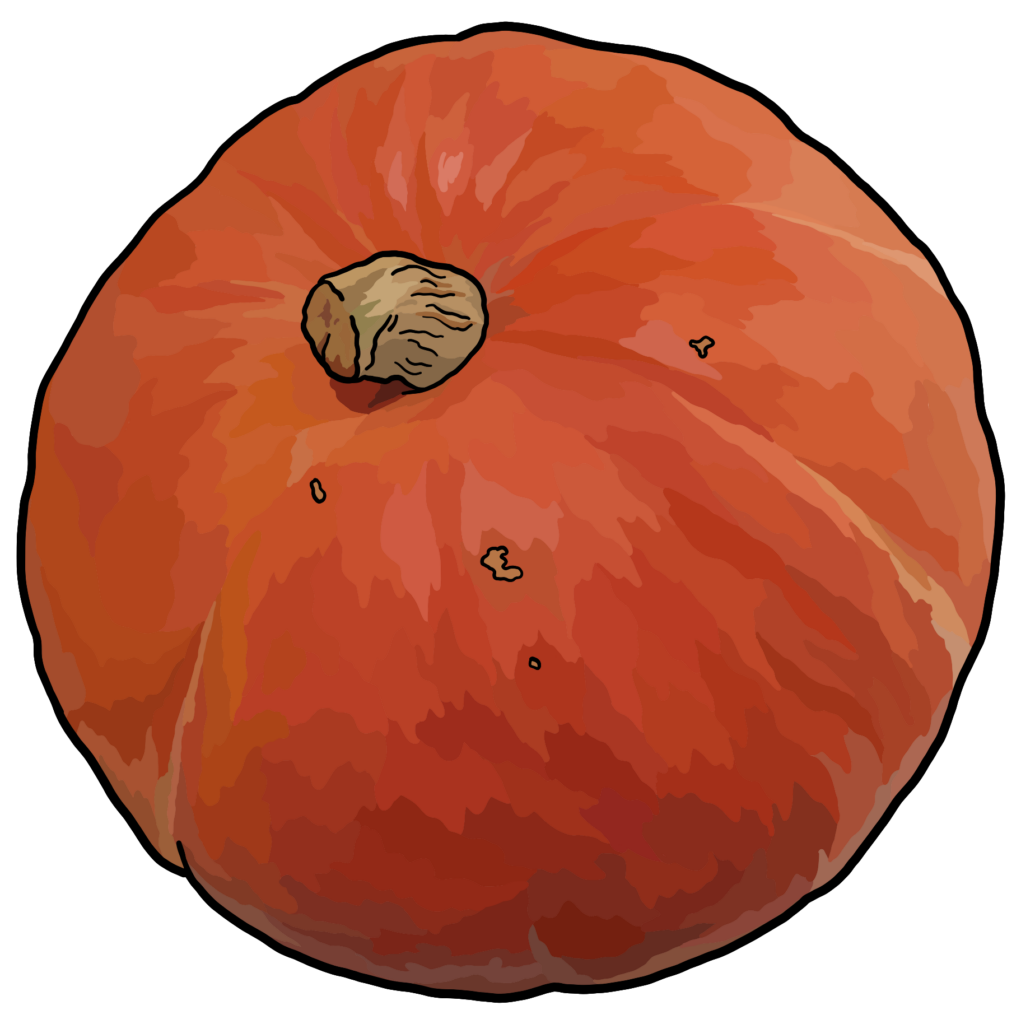
Sunshine Kabocha Squash
The sunshine kabocha were developed by Johnny’s Selected Seeds founder, Rob Johnston. In the 1970s, he initially crossed a red kuri with a golden nugget and then, after some time, crossed this squash with a green kabocha variety. After years of perfecting, the sunshine kabocha was commercially introduced in 2004.
Kabocha can be added in cubes to gratins, risottos, soups, stews, curries, and pasta. It can also be roasted on its own or battered and fried tempura-style or used in sushi. When cooked and puréed, it can be used to make bread, croquet, desserts, cakes, and sauces.
AKA: Japanese Pumpkin
Type: hybrid
Size: 3-8 lb
Flavor: buttery, sweet, rich, nutty, and very sweet
Texture: smooth, finely grained, creamy, tender
Storage: one to two months (uncut, in a cool and dry place)
Goes well with: pears, apples, lemon, kale, spinach, eggplant, garlic, sage, parsley, shallots, cilantro, nutmeg, clove, curry spice, honey, brown sugar, coconut milk, butter, cream, Italian sausage, and parmesan cheese

Koginut Squash
Koginut squash is a very recent cultivar, released to the market in 2018 by Row 7 Seeds. It’s part of a new generation of seeds developed with the help of chefs, with flavor at the forefront of the development rather than look and uniformity. They are currently only available at specialty food markets and farmer’s markets. But when you do locate one, don’t pass it up.
Koginuts are best roasted, and once cooked, they can be added to baked goods, soups, risottos, sauces, soups, and curries. In cubes, they can be added to salads, grain bowls, and other such preparations.
AKA: Robin’s Koginut
Size: 2-4 lb
Flavor: sweet, nutty, hints of citrus and vanilla
Texture: silky, creamy, tender
Storage: one to three months (uncut, in a cool and dry place)
Goes well with: poultry, beef, fish, carrots, arugula, spinach, fennel, basil, thyme, cinnamon, nutmeg, maple syrup, fruits such as apples and pears, nuts such as pine nuts, pistachios, and pecans, rice, quinoa, and barley
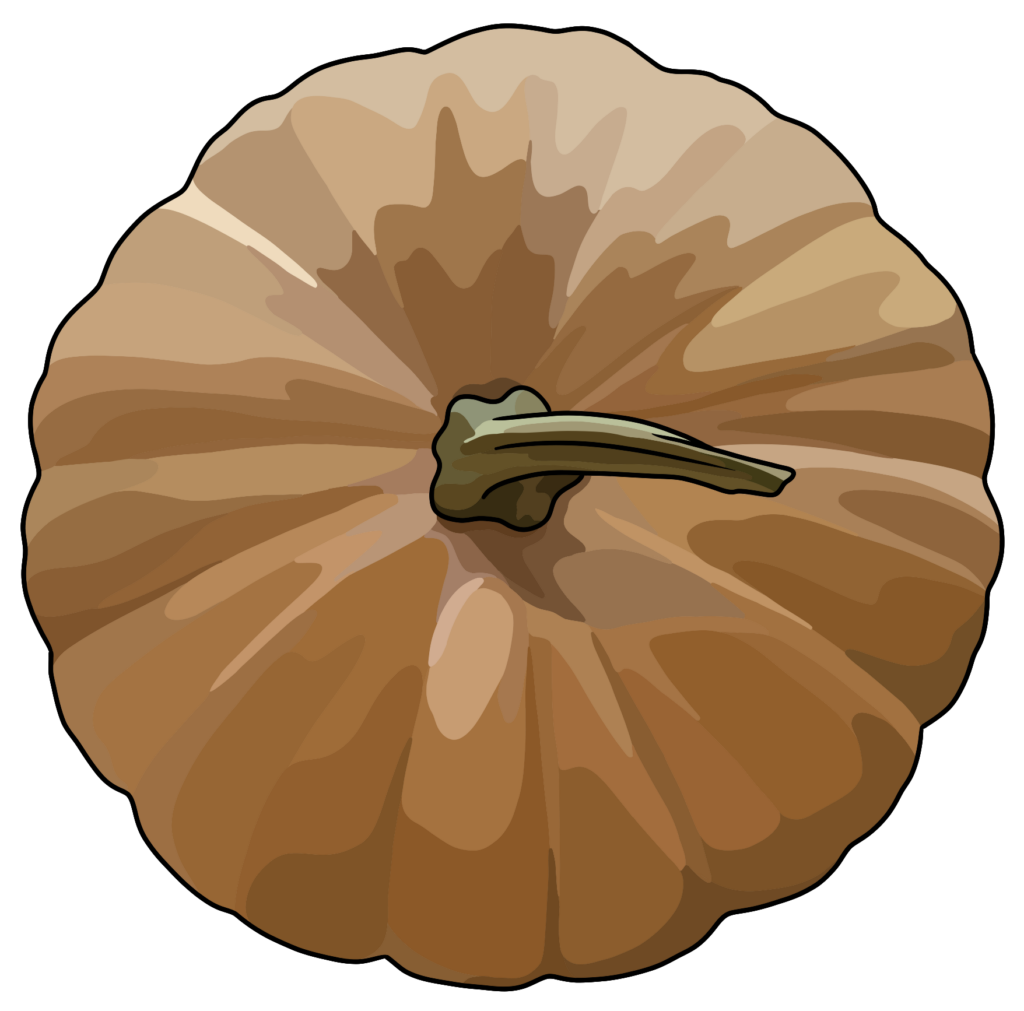
Long Island Cheese Squash
This squash is one of the oldest heirloom varieties. It is believed to have originated in Central or South America before making its way to the Atlantic seaboard in the early 1800s. It was very popular (especially as a pie variety) until the 1960s when other varieties better suited to commercial canning pushed them out. They were saved in the 1970s as part of the Long Island Seed Project. Today, they are almost exclusively found at farmer’s markets and specialty food shops. The name comes from their resemblance to a cheese wheel.
These squash can be roasted, baked, sautéd, grilled, braised, fried, and boiled. Long Island cheese squash can be used the same way a pumpkin pie might be, and it is especially good for pies.
AKA: Long Island Cheese Pumpkin
Type: heirloom
Size: 6-10 lb
Flavor: mild, sweet, earthy
Texture: tender, creamy
Storage: three to six months (uncut, in a cool and dry place)
Goes well with: Gruyère, parmesan, thyme, nutmeg, cinnamon, cloves, allspice, ginger, poultry, sausage, turkey, bacon, bread, onions, garlic, shallots, parsnips, leeks, fennel, corn, carrots, turnips, green apples, heavy cream
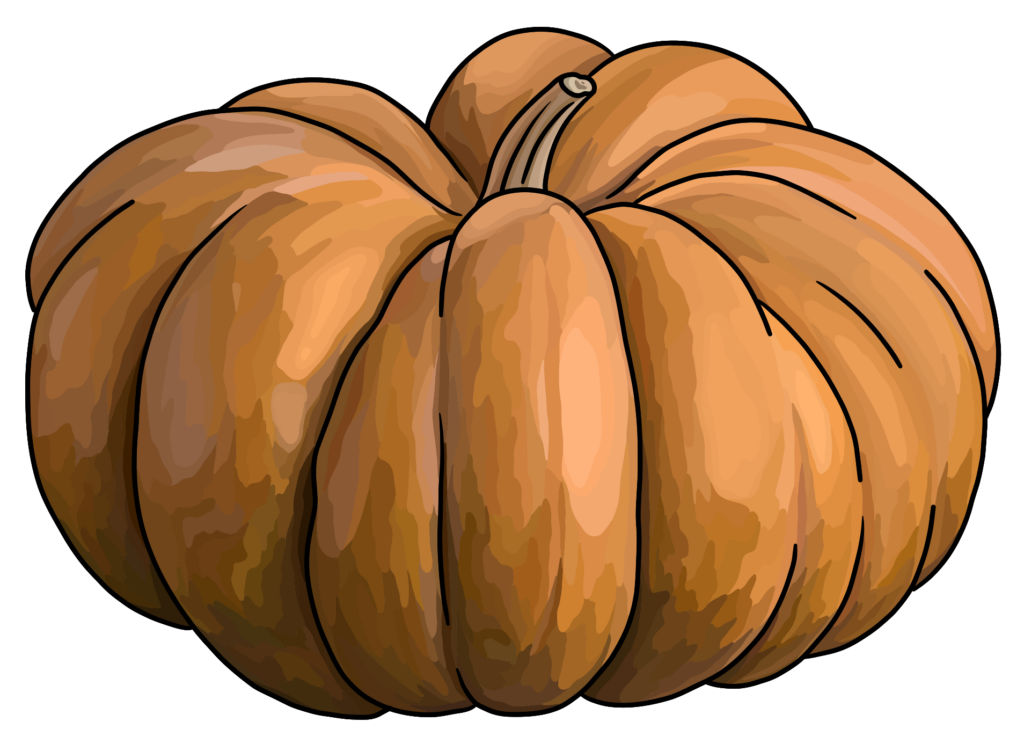
Musquee de Provence Squash
This squash was developed in the Provence region of France in the 19th century and introduced to the US in 1899. Because of its large size, it’s commonly sold in wedges in France.
Musquee de Provence squash can be roasted, sautéd, baked, boiled, and grilled. Cooked, it can be used in pies and other baked goods, in soups, risotto, pasta, and other applications. But it’s also known for its ability to be eaten raw. It can be served in salads, enjoyed as a snack similar to cantaloupe, or used as a garnish.
AKA: fairytale pumpkin, musque squash
Type: heirloom
Size: 15-20 lb
Flavor: mild, sweet, spicy scent
Texture: tender
Storage: nine months (uncut, in a cool and dry place)
Goes well with: pecans, rum, eggs, onions, garlic, ground beef, poultry, sausage, fennel seeds, red bell peppers, zucchini, brown rice, quinoa, farro

Pie Pumpkin
This variety of pumpkin originated in New England in the 1860s, introduced by the horticulturist Fearing Burr. They descended from other pumpkin varieties that had been cultivated by Indigenous Americans for centuries.
Pie pumpkins are most commonly used for baking. Roast the pumpkin, scoop out and puree the cooked flesh, then combine with eggs, cream, sugar, and spices and bake into a pie. Fold the puréed pumpkin into muffins or pancake batter.
AKA: sugar pie pumpkin, sugar pumpkin, New England pumpkins
Type: heirloom
Size: 2-7 lb
Flavor: mildly sweet, earthy, and nutty
Texture: tender and buttery
Storage: two to three months (uncut, in a cool and dry place)
Goes well with: sage, rosemary, thyme, oregano, coriander, cinnamon, cloves, nutmeg, Swiss chard, spinach, kale, peas, beans, hazelnuts, lobster, ham, potatoes, tomatoes, apples, and Gruyère cheese
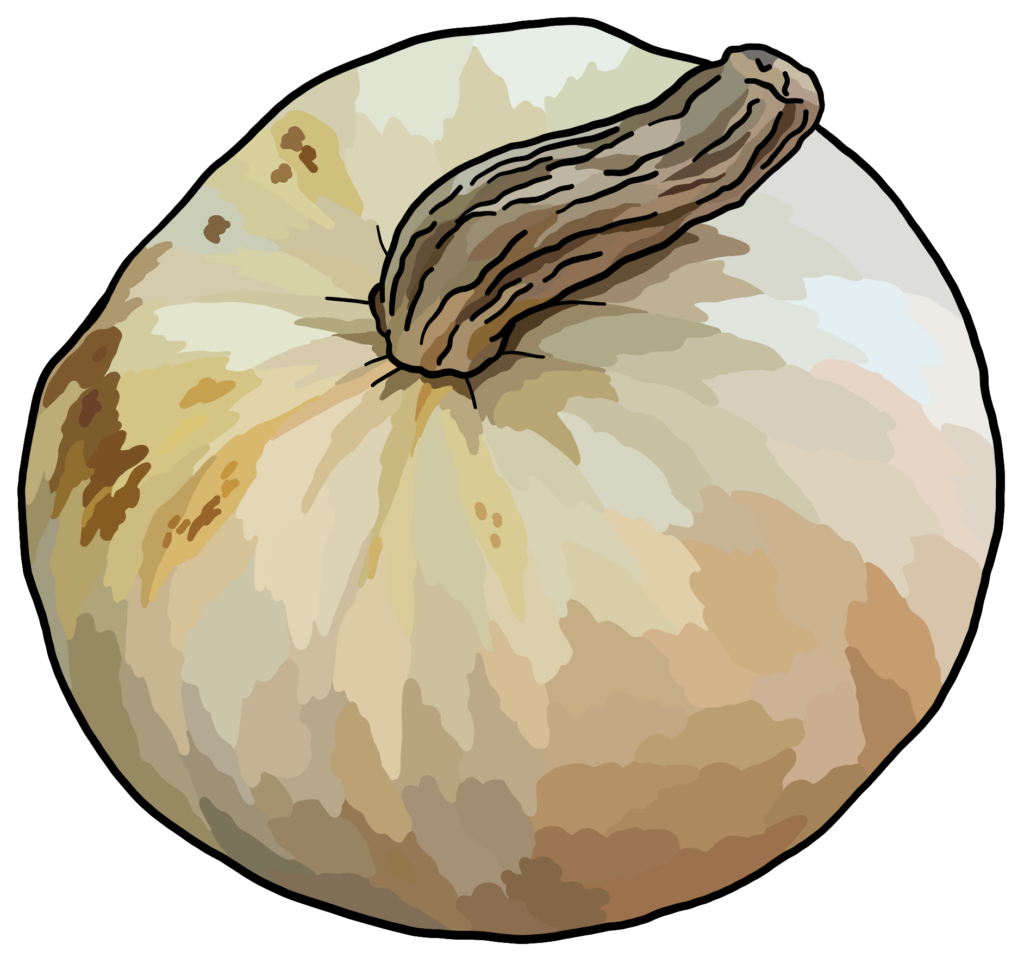
Queen of Smyrna Squash
The Queen of Smyrna squash hails from Smyrna, Maine, where it was a natural mutation from a kabocha squash. The skin is white, and the flesh is yellow-orange. It is a slightly dry squash with a sweet and nutty flavor.
As a member of the kabocha family, this squash can be used in the same ways. It’s truly delicious in a soup with wild mushrooms and herbs. It’s still a new ingredient to many, so it doesn’t have many recipes created. You can use your creativity!
Type: Maine heritage squash
Flavor: sweet, rich, nutty, similar to kabocha
Texture: semi-dry, dense, smooth
Goes well with: mushrooms, thyme, nutmeg, chestnuts, sharp cheese, jalapeño
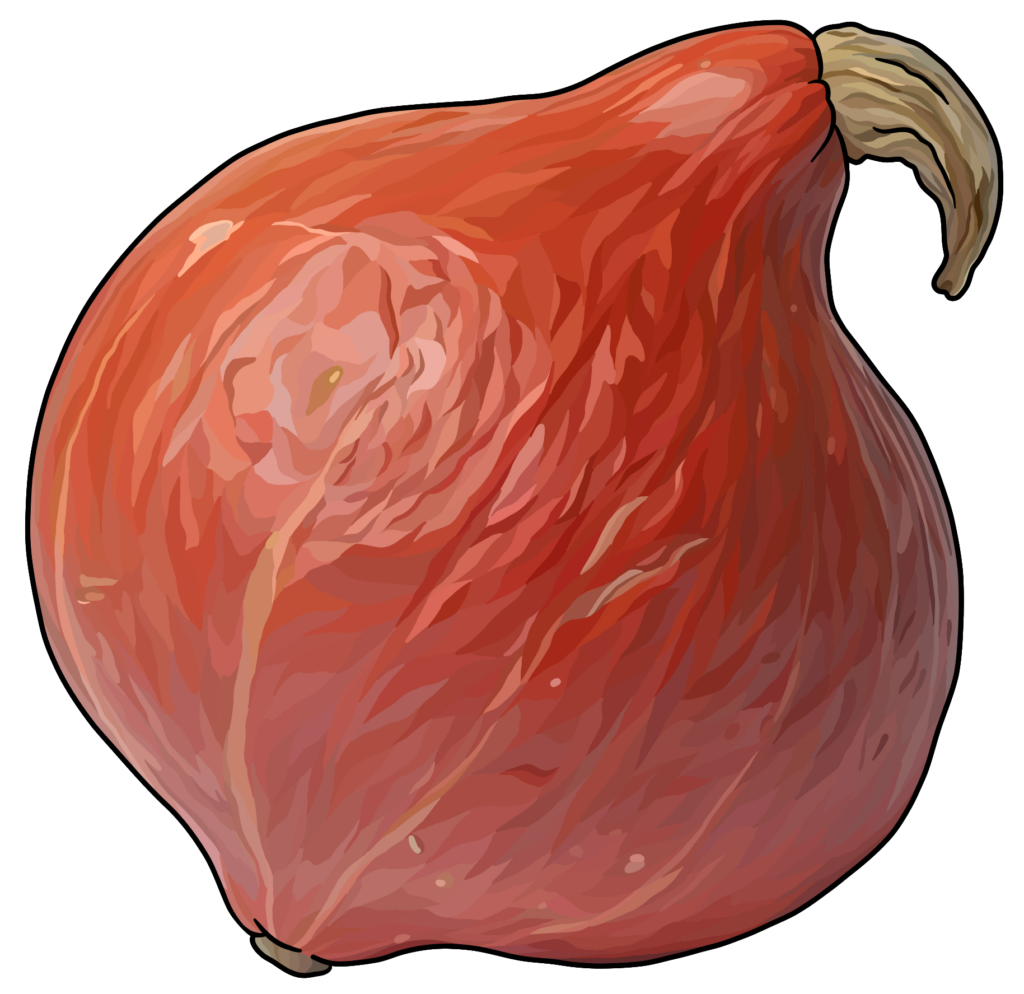
Red Kuri Squash
Red kuri is a Japanese squash that originated on the north island of Hokkaido in the 1920s. It is believed to have been developed from the Hubbard squash in search of a smaller variety with thinner skin and a nuttier flavor. The word kuri means “chestnut” in Japanese, its primary flavor marker.
Red kuri can be roasted, baked, steamed, boiled, and sautéd. It can be puréed and added to soups, risotto, stews, and curries. It’s also an excellent squash for stuffing with meats and veggies and baking.
AKA: climbing onion squash, Hokkaido squash, baby red hubbard, uchiki kuri, potimarron
Type: heirloom
Size: 3-7 lb
Flavor: sweet, nutty, reminiscent of chestnuts
Texture: smooth, tender
Storage: three to six months (uncut, in a cool and dry place)
Goes well with: onion, bay leaf, fresh herbs, leeks, dried cranberries, white beans, mustard greens, maple syrup, curry powder, roasted fennel, pecans, cinnamon, nutmeg, goat cheese, parmesan cheese, olive oil
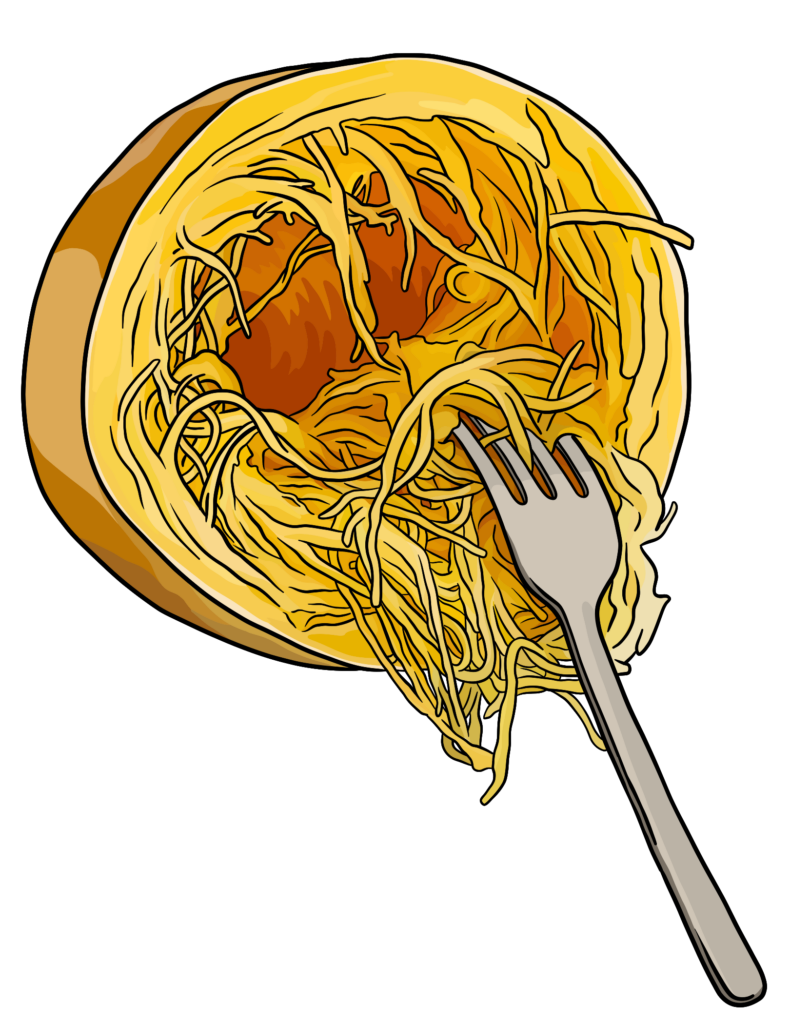
Spaghetti Squash
Spaghetti squash originated in China sometime before 1850. In the 1920s, it was brought to the Aichi Prefectural Agricultural Research Station in Japan, where they developed an improved variety that reached the market in 1934 under the name Somen Nankin. Shortly thereafter, it arrived on the US market as vegetable spaghetti. It didn’t gain much popularity until WWII when processed food shortages made it desirable as a pasta substitute.
Steam or bake whole squash, then halve, remove seeds, and scrape flesh with a fork to separate.
AKA: vegetable spaghetti, noodle squash, mandarin squash, and vegetable marrow
Type: heirloom
Size: 4-8 lb
Flavor: mild and slightly sweet
Texture: separates into long, translucent strings that resemble angel hair pasta; tender and slightly crunchy
Storage: three to six months (uncut, in a cool and dry place)
Goes well with: tomato, onions, garlic, greens, fresh herbs such as thyme, basil, and oregano, parsley, and mint, cucumbers, zucchini, mushrooms, bell pepper, red pepper, snap peas, soy sauce, fish sauce, tamari, pine nuts, cream, parmesan, ricotta, mozzarella and feta cheese, shrimp, chicken, ground beef, Italian sausage, and pancetta

Sweet Dumpling Squash
The sweet dumping squash originated in Yokohama at Sakata Seed Corporation in 1976. It was part of a practice of taking large American squash varieties and miniaturizing them for home gardens and home cooks. When it was introduced in America, it had the unfortunate name “vegetable gourd,” which did not appeal to consumers. It gained popularity once it was rebranded as the sweet dumpling squash.
Dumpling squash can be roasted, sautéd, baked, or steamed. It is an ideal size for stuffing with meats, cheeses, grains, or other vegetables, and it can be roasted and served as a stand-alone side dish. It’s also particularly good roasted with a sweet custard inside.
AKA: dumpling squash
Type: winter squash
Size: 0.75-1 lb
Flavor: sweet and mild
Texture: smooth, light, and tender
Storage: two months (uncut, in a cool and dry place)
Goes well with: Italian parsley, sage, parsnip, beets, arugula, nutmeg, curry, nuts, strong cheeses, poultry, pears, apple, maple syrup, brown sugar, butter, and dried fruits
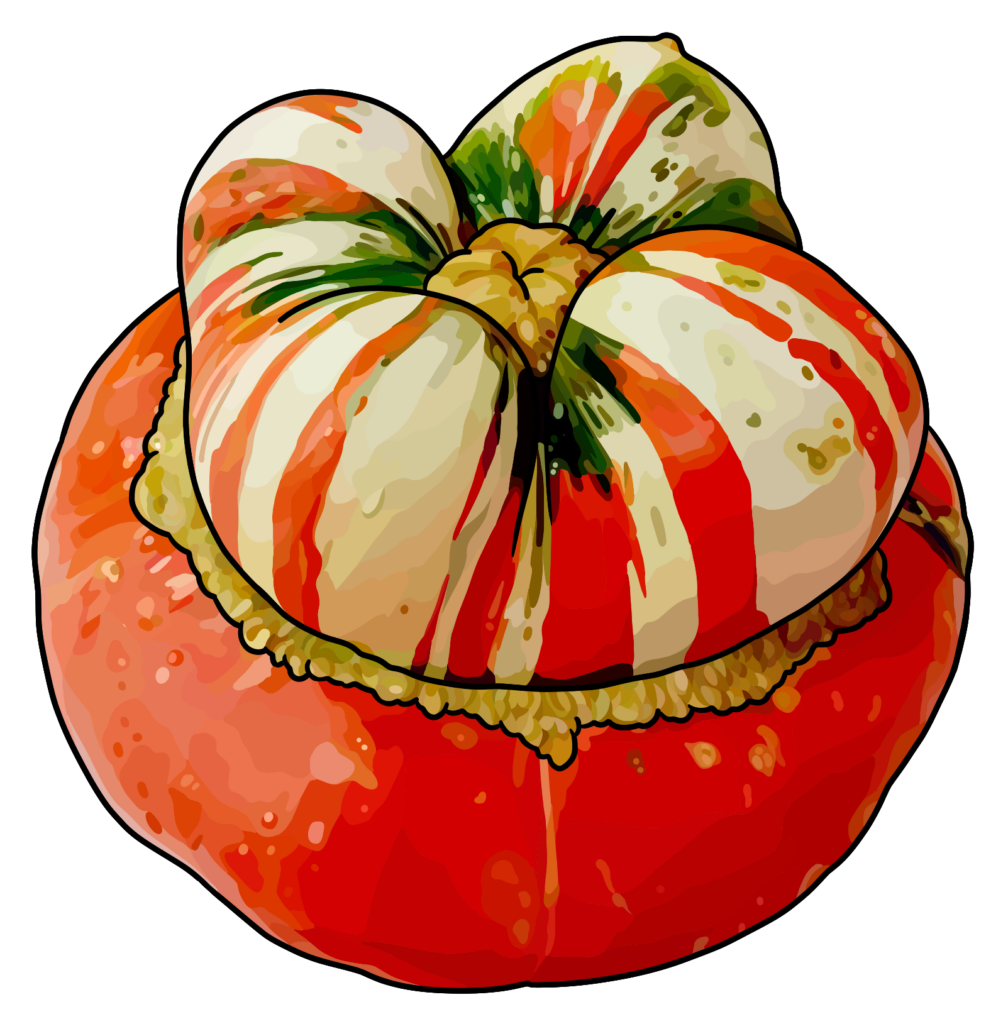
Turban Squash
Turban squash is a category of winter squash known for its turban-like cap. It’s an heirloom variety that has been cultivated for centuries, but before the 1800s, turban varieties were mainly grown as ornamentals since they were watery and flavorless. When the American turban squash appeared in the 19th century, it boasted a much more desirable flavor and texture.
Because of its odd shape, the acorn or turban top is usually sliced off first, then the body is sliced into wedges or cubes. It can be roasted, baked, or steamed. It makes a good side on its own but can also be added to soups, grain bowls, and salads. Puréed, it can be added to sauces and soups.
Type: heirloom
Flavor: mild to sweet
Size: 5 lb
Texture: floury
Storage: two weeks (uncut, in a cool and dry place)
Goes well with: pear, apple, chard, corn, kale, celery, carrots, mushrooms, onions, garlic, parsley, cilantro, nutmeg, cardamom, brown sugar, butter, cream, melting and hard cheeses, toasted nuts, tahini dressing, sausage, ground beef, bacon, roasted chicken
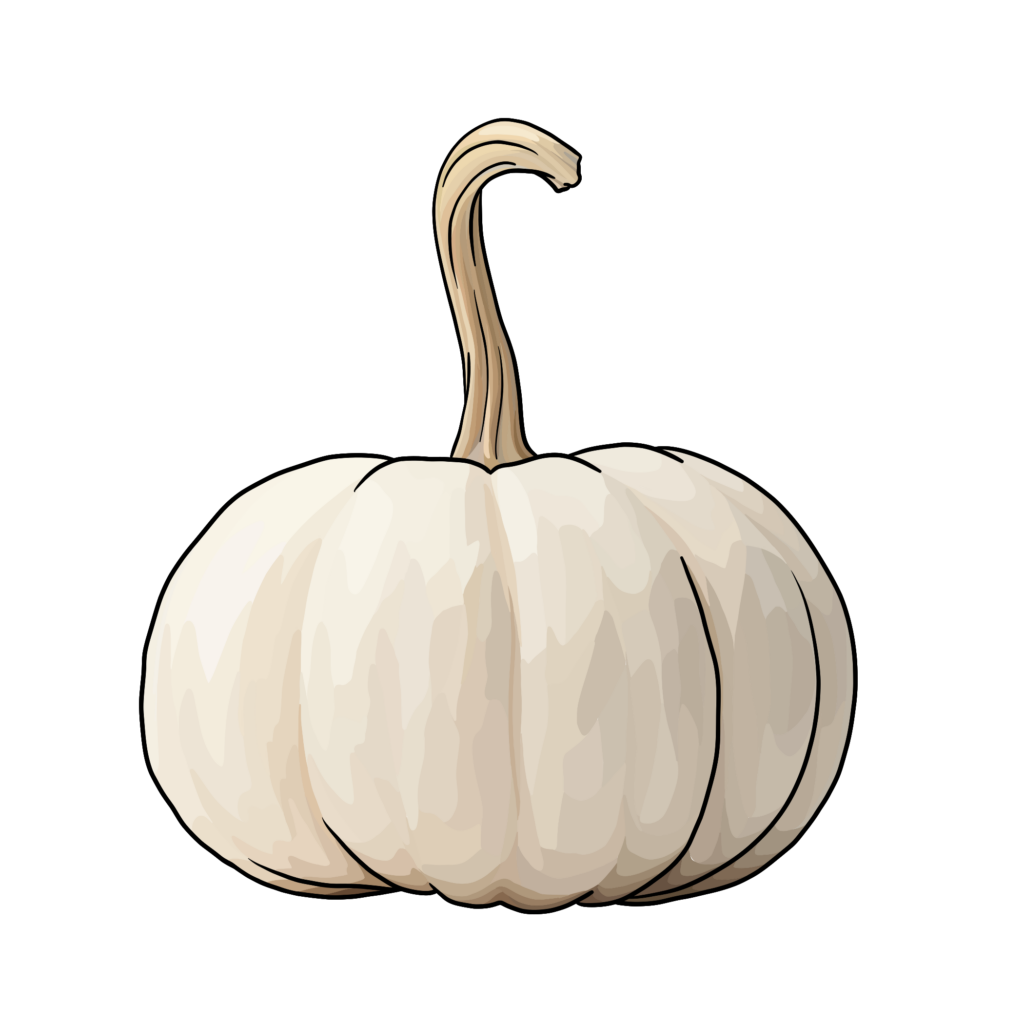
White Pumpkin
White pumpkins are a category of winter squash that is not found in the wild. They gained popularity in the 80s and 90s as a novelty for autumn decor. There are several cultivars, including Lumina, Ghost, Full Moon, Valenciano, Silver Moon, and Casper pumpkins. Though they are mainly used as ornamentals, they are edible, so you can cook them up when they’re no longer needed for decoration. They’re milder in flavor than an orange pumpkin.
White pumpkins can be roasted, baked, and boiled. They can also be added to chilis, soups, and curries. Blended, they’re good for risottos, soups, ravioli, lasagna, and mac and cheese. They’re also great for adding to bread like challah and dinner rolls. And, of course, you can make them into pie.
Type: natural mutation
Flavor: mild, earthy, lightly sweet
Size: 7-15 lb
Texture: tender
Storage: one to three months (uncut, in a cool and dry place)
Goes well with: cinnamon, nutmeg, cloves, cardamom, rice, quinoa, cranberries, walnuts, hazelnuts, pine nuts, peanuts, sausage, chicken, turkey, mushrooms, broccoli, garlic, onions, sage, thyme


